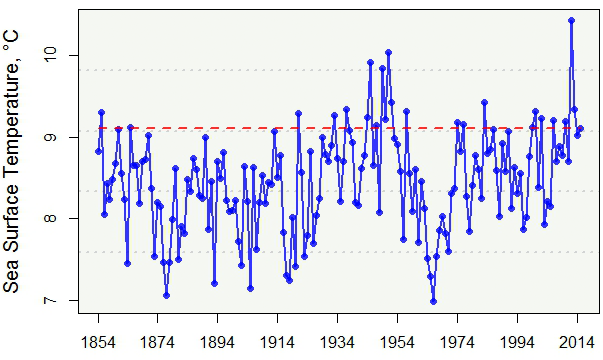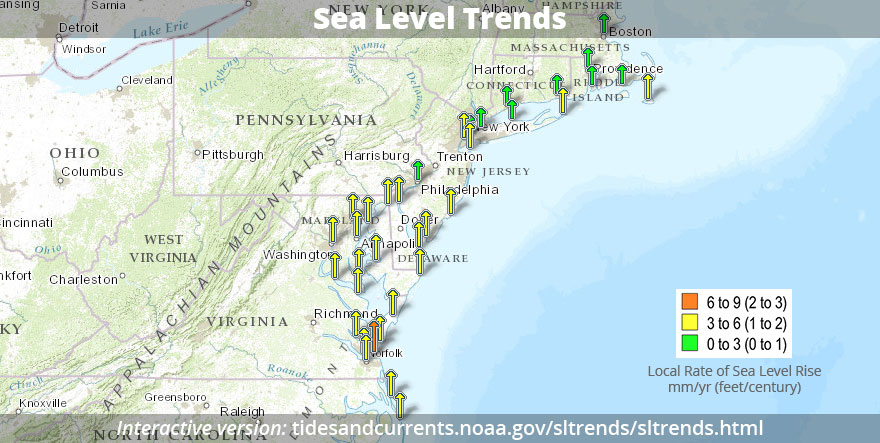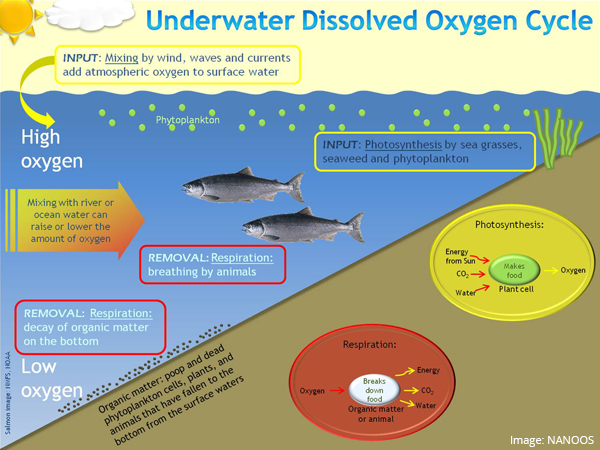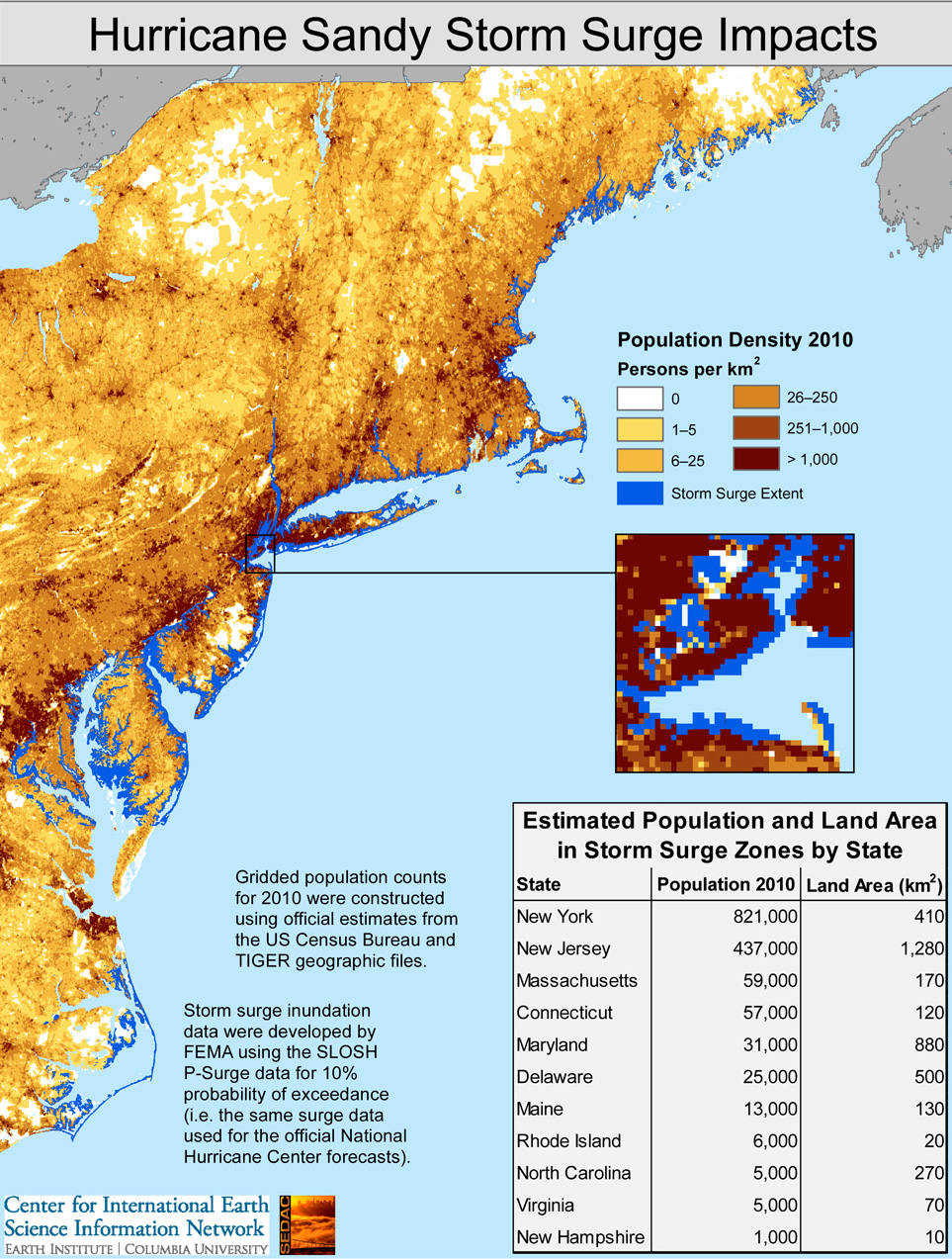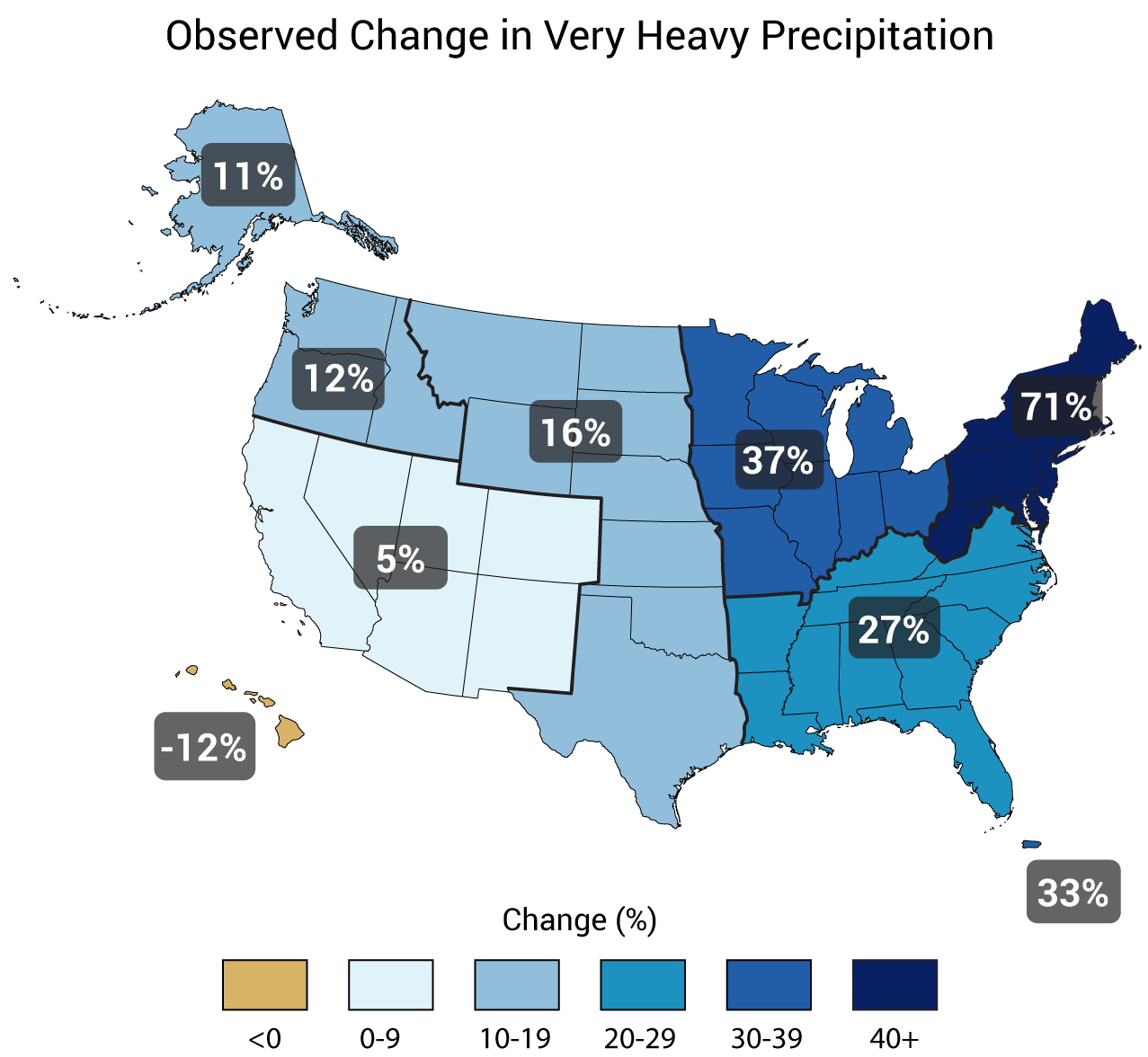Ecosystem Responses to Climate Change
Rapid changes in climate are influencing coastal and ocean ecosystems of the Mid-Atlantic. Some of the major observed and expected changes to the physical and chemical characteristics of coastal and ocean ecosystems include (Link et al. 2015):
- Warmer ocean waters
- Sea level rise
- Reduced ocean pH (acidification)
- Reduced dissolved oxygen
- Altered storm tracks and intensity
- Changes in precipitation and freshwater input from rivers
Changes in these characteristics can result in altered conditions of coastal and ocean ecosystems such as ocean circulation, stratification, nutrient availability and ecosystem connectivity (EPA 2015). The Mid-Atlantic region has already begun to experience several of these changes to physical/chemical characteristics.
Warmer Ocean Waters and Shifting Species Ranges
In 2012, water temperatures on the Northeast United States Large Marine Ecosystem, which includes the Mid-Atlantic region, reached the highest levels in over 150 years of recorded observations (NEFSC 2015). There is high confidence that air temperature and sea surface temperature will increase by 3 to 6° C and 2 to 4° C respectively by the year 2100 in the Northeast Large Marine Ecosystem (NEFSC 2015). Warmer waters will cause cold-water species to shift their geographic distributions, and more tropical species are expected to enter the region. As a result of species shifts, the composition of communities and species interactions will change, which will affect ecosystem structure, function, resource availability, and fishing patterns (Link et al. 2015). Shifts in the distribution over 20 species of commercially and recreationally important fish species in the region have been documented (NEFSC 2015). Twenty-four of 36 fish stocks on the Northeast Shelf are shifting their ranges north and/or moving into deeper water (Nye et al. 2009, Pinsky et al. 2013). Warming waters also affect the timing of important events such as reproduction, feeding, and migration. For example, if the distribution and abundance of forage fish shifts drastically, seabirds that rely on these fish may not find enough prey during their nesting season (Miles et al. 2015).
Sea surface temperature data reveal a recent warming trend in the region. (Source: NOAA)
Sea Level Rise
The Mid-Atlantic region has experienced more sea level rise than the global mean, at about 1 foot over the twentieth century (between 2.4 and 4.4 mm per year) (CCSP 2009). There is evidence that this rate is increasing (Parris et al. 2012, CCSP 2009). Sea level rise threatens a large extent of vital habitat in the Mid-Atlantic, including marshes, tidal wetlands, and barrier island complexes. Rising seas will displace many freshwater and estuarine species sensitive to full ocean salinities (EPA 2015). Combined with the impact of altered storm tracks and intensity, sea level rise contributes to and could exacerbate erosion of shorelines and beaches, as well as inundation of important nearshore habitats (CCSP 2009). Between 1998 and 2004, saltwater intrusion and inundation were identified as the primary causes of wetland loss in the Mid-Atlantic region (Dahl and Stedman 2013).
Observed local trends in sea level based on tide station measurements. Interactive version: NOAA
Ocean Acidification
The quickly rising levels of carbon dioxide in the atmosphere are leading to ocean acidification, as ocean waters absorb carbon dioxide. Global ocean pH has declined by about 0.1 units since pre-industrial times, representing an increase in acidity of about 30 percent (Feely et al. 2009). The Mid-Atlantic may be especially vulnerable to acidification in coastal waters, where high nutrient levels and rapid growth of plankton further reduce pH. Ocean acidification causes organisms to expend more energy to regulate their body chemistry and reduces the availability of calcium carbonate, which clams, oysters, lobsters, and other species require to build and maintain shells and skeletons. As a result, ocean acidification could have important effects on numerous culturally and commercially important species in the region (Wang et al. 2013, Ekstrom et al. 2015).
Learn more about the Mid-Atlantic Regional Council on the Ocean’s (MARCO) work on ocean and coastal acidification through co-coordination with Mid-Atlantic Coastal Acidification Network (MACAN).
Reduced Dissolved Oxygen
Presently, some coastal waters are prone to having low levels of dissolved oxygen, particularly where high nutrient loads cause eutrophication. Low dissolved oxygen, or hypoxia, can kill marine life or cause species move to other places. Scarcity of dissolved oxygen may become a more widespread problem, even in offshore waters, as temperatures increase with climate change because warmer water holds less oxygen. At the same time, however, other factors could partially offset that trend. For example, climate change is expected to increase the frequency of severe storms and windiness, which serve to “mix” air into seawater and increase dissolved oxygen. In addition, future expansion or restoration of habitats such as eelgrass beds or kelp forests, which generate oxygen, could provide some protection against low dissolved oxygen (Link et al. 2015).
Altered Storm Tracks and Intensity
As a result of climate change, the strength of hurricanes and the number of strong (Category 4 and 5) hurricanes are projected to increase over the North Atlantic (Melillo et al. 2014). Warmer air and sea surface temperatures provide more energy for hurricanes. Coastal and inland flooding, and damage from downed trees are all concerns associated with a potential increase in storm intensity. Storms like Hurricane Sandy have had implications for infrastructure, coastal communities, and tourism as well as ecosystem components such as erodible beaches and wetlands.
Changes in Precipitation and Freshwater Input from Rivers
The region from Washington, DC, to Maine has experienced a greater recent increase in extreme precipitation than any other region in the U.S. (Karl et al. 2009). Changes in precipitation are difficult to predict, but some models estimate that winter precipitation may increase by about 5% in the Mid-Atlantic (Horton et al. 2014). More precipitation increases the freshwater input from rivers to coastal water bodies and the ocean. Pulses of freshwater can lead to stratification of the water column and reduced bottom-water oxygen.
This map shows increases in the amount of precipitation that falls in very heavy storms (defined as the heaviest one percent of all daily events) from 1958 to 2012 for each region of the continental United States. The Northeast region has experienced the greatest increase. (Source: National Climate Assessment, updated from Karl et al. 2009)
Selected Sources of Further Information
Current conditions of the Northeast Shelf Large Marine Ecosystem
NOAA Digital Coast Sea Level Rise Viewer
The National Climate Assessment
Ocean Climate Change Indicators – US EPA
Record-breaking water temperatures off mid-Atlantic and Northeast coasts – The Washington Post
Warming oceans drive east coast fish to cooler waters – Scientific American
Climate-ready options for fisheries managers – The Pew Charitable Trusts
Shifting skies: Migratory birds in a warming world – National Wildlife Federation

